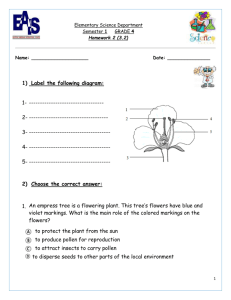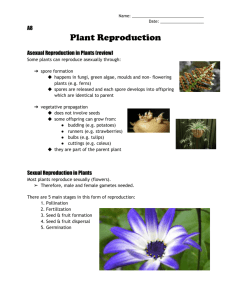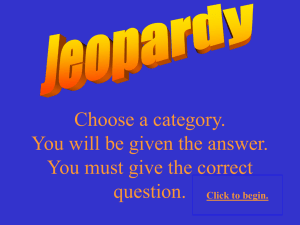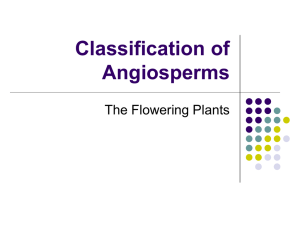KEY - Madison County Schools
advertisement
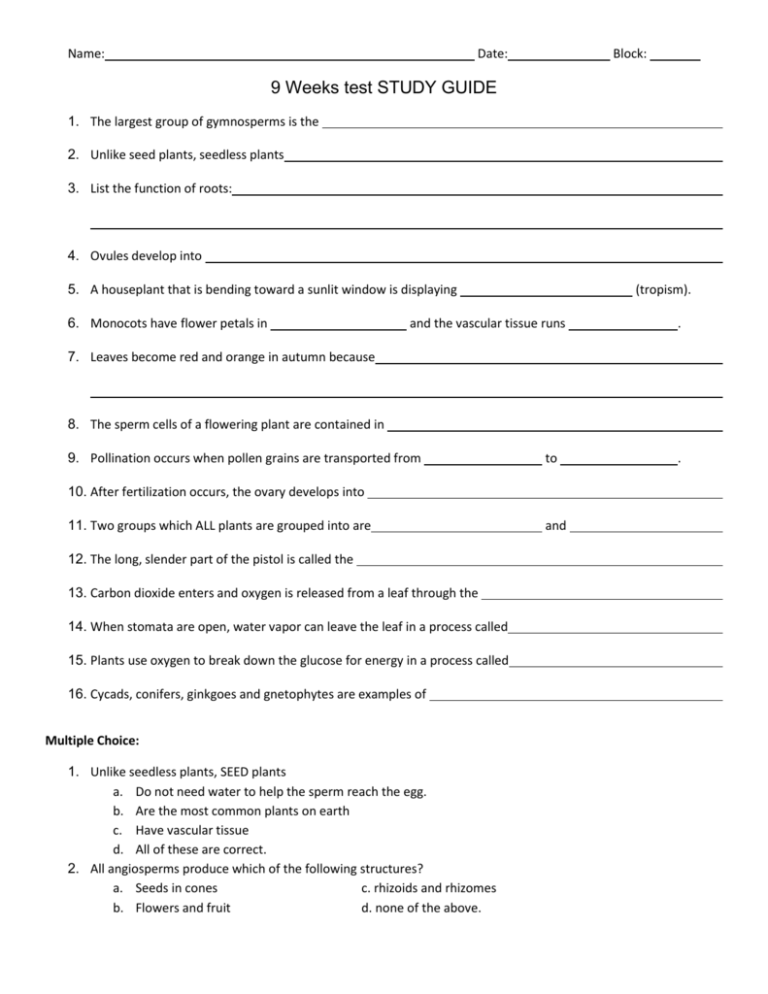
Name: Date: Block: 9 Weeks test STUDY GUIDE 1. The largest group of gymnosperms is the 2. Unlike seed plants, seedless plants 3. List the function of roots: 4. Ovules develop into 5. A houseplant that is bending toward a sunlit window is displaying 6. Monocots have flower petals in (tropism). and the vascular tissue runs . 7. Leaves become red and orange in autumn because 8. The sperm cells of a flowering plant are contained in 9. Pollination occurs when pollen grains are transported from to 10. After fertilization occurs, the ovary develops into 11. Two groups which ALL plants are grouped into are 12. The long, slender part of the pistol is called the 13. Carbon dioxide enters and oxygen is released from a leaf through the 14. When stomata are open, water vapor can leave the leaf in a process called 15. Plants use oxygen to break down the glucose for energy in a process called 16. Cycads, conifers, ginkgoes and gnetophytes are examples of Multiple Choice: 1. Unlike seedless plants, SEED plants a. Do not need water to help the sperm reach the egg. b. Are the most common plants on earth c. Have vascular tissue d. All of these are correct. 2. All angiosperms produce which of the following structures? a. Seeds in cones c. rhizoids and rhizomes b. Flowers and fruit d. none of the above. and . 3. All gymnosperms produce which of the following structures? a. Seeds in cones c. rhizoids and rhizomes b. Flowers and fruit d. none of the above. 4. If you plant a tree on the side of a cliff, it will a. Grow straight out b. Bend upward because the shoot tips have positive gravitropism c. Bend upward because the shoot tips have negative gravitropism d. Bend downward 5. Which of the following sequences show the correct order of events that occur after an insect brings pollen to a flower? a. Germination, fertilization, pollination c. pollination, fertilization, germination b. Fertilization, germination, pollination d. pollination, germination, fertilization 6. The purpose of trees losing their leave before the winter or dry season is a. To stop the tree from losing heat through the leaves. b. To help survive low temperature and long periods without rain. c. To prevent cold air from entering the tree through the leaves. d. None of the above. 7. The organs of the plant that photosynthesize are the a. Roots c. Flowers b. Stems d. Leaves 8. Which of the following is a fact, not an opinion, about leaves. a. Leaves are a part of the root system. b. Guard cells are the most important cells of the leaf because they open and close the stoma. c. In a plant, xylem and phloem transport the necessary materials for life. d. We do not need plants like cycads because they are so similar to palm trees. Answer the following question in the space provided. Zygote pollination germination embryo fertilization 9. Describe reproduction in seed plants. Use the vocabulary words listed above. seed 9 Weeks test STUDY GUIDE KEY 1. The largest group of gymnosperms is the CONIFER 2. Unlike seed plants, seedless plants must have water to reproduce. 3. List the function of roots: anchors the plant to the soil, collects and transports water and minerals and it sometimes stores food. 4. Ovules develop into seeds. 5. A houseplant that is bending toward a sunlit window is displaying phototropism (tropism). 6. Monocots have flower petals in sets of 3s and the vascular tissue runs parallel. 7. Leaves become red and orange in autumn because the plants are allowing their cholorplast to die off and the red and orange pigments are showing through. 8. The sperm cells of a flowering plant are contained in the pollen located on the anther. 9. Pollination occurs when pollen grains are transported from anters to stigma. 10. After fertilization occurs, the ovary develops into fruit. 11. Two groups which ALL plants are grouped into are vascular and nonvascular 12. The long, slender part of the pistol is called the style. 13. Carbon dioxide enters and oxygen is released from a leaf through the stoma or stomata. 14. When stomata are open, water vapor can leave the leaf in a process called transpiration. 15. Plants use oxygen to break down the glucose for energy in a process called cellular respiraton. 16. Cycads, conifers, ginkgoes and gnetophytes are examples of gymnosperms. Multiple Choice: 10 Unlike seedless plants, SEED plants a. Do not need water to help the sperm reach the egg. b. Are the most common plants on earth c. Have vascular tissue d. All of these are correct. 11 All angiosperms produce which of the following structures? a. Seeds in cones c. rhizoids and rhizomes b. Flowers and fruit d. none of the above. 12 All gymnosperms produce which of the following structures? a. Seeds in cones c. rhizoids and rhizomes b. Flowers and fruit d. none of the above. 13 If you plant a tree on the side of a cliff, it will a. Grow straight out b. Bend upward because the shoot tips have positive gravitropism c. Bend upward because the shoot tips have negative gravitropism d. Bend downward 14 Which of the following sequences show the correct order of events that occur after an insect brings pollen to a flower? a. Germination, fertilization, pollination c. pollination, fertilization, germination b. Fertilization, germination, pollination d. pollination, germination, fertilization 15 The purpose of trees losing their leave before the winter or dry season is a. To stop the tree from losing heat through the leaves. b. To help survive low temperature and long periods without rain. c. To prevent cold air from entering the tree through the leaves. d. None of the above. 16 The organs of the plant that photosynthesize are the a. Roots c. Flowers b. Stems d. Leaves 17 Which of the following is a fact, not an opinion, about leaves. a. Leaves are a part of the root system. b. Guard cells are the most important cells of the leaf because they open and close the stoma. c. In a plant, xylem and phloem transport the necessary materials for life. d. We do not need plants like cycads because they are so similar to palm trees. Answer the following question in the space provided. Zygote pollination germination embryo fertilization seed 18 Describe reproduction in seed plants. Use the vocabulary words listed above. During pollination, the sperm is released from the pollen and joins with the egg. This is called fertilization and it forms a zygote. Once the zygote is formed, it can develop into a seed. When the seed lands in the right environment it can begin to germinate. Germination is when the embryo begins to push out of the seed and begins to grow.
